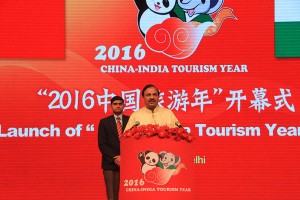Can Panda and Elephant dance together? Yes, it would seem do, going by the huge turnout at the launch of the China-India Tourism Year 2016 in the Indian capital. The captivating performance of Huangmei Opera vividly evoked local culture and music of Anhui, Jiangxi and the Hubei districts in China, inviting Indians to visit this diverse country boasting an ancient civilisation and world-class infrastructure. Passion and compassion mingled in this Chinese love story, The Seventh Fairy Maiden, whetting curiosity of the audience to dig deeper into folksy culture of China.
One only hopes that this operatic magic will translate into greater tourist flows. More Indians and Chinese are travelling to each other’s country than before, but the current figures are just the tip of the iceberg given the sheer number of people in the world’s two most populous countries. China’s ambassador to India Le Yucheng, who was among those present at the launch ceremony, admitted this gap between reality and potential, but struck an optimistic note. “Last year, 900,000 two-way visits were recorded between China and India. However, compared to our combined population of 2.5 billion, the potential of tourism exchanges is yet to be fully realised, but we are confident that we will set a record of one million two-way visits in 2016 this year,” said the Chinese envoy.
1 million-plus target
The massive turn-out at the performance of the Chinese opera, which was attended by over 1,000 people in a packed auditorium, underlined the potential market waiting to be tapped. Li Jinzao, Chairman of the China National Tourism Administration (CNTA), read out a congratulatory message from Chinese President Xi Jinping at the launch event, indicating that the drive to expand two-way tourist flows has the backing of the top leadership in China. The Chinese leader stressed that the two countries have been building cultural relationship through exchanges and mutual learning since centuries. “The two countries could carry forward traditional friendship, enhance win-win cooperation and expand cultural exchanges, so as to further contribute to world peace and development.”
Mr Li underlined the potential of tourism in deepening a special bond between India and China friendly communication. He believed that the “Visit India Year” and “Visit China Year” would bring a new era of more than one million two-way visits and make China-India closer development partnership more vigorous.
The ties between India and China go back centuries when Buddhists teachers travelled to China. The bond has deepened over the years as religion and ideas travelled the non-existent borders centuries ago, which makes the two nations more similar than perceived. A unique blend of young nations but ancient civilisations, India and China are now focusing on enhancing cultural linages, and tourism could be a force multiplier in this process.
India’s Culture Minister Mahesh Sharma was also upbeat about the prospects of tourism between the two Asian neihbours. The Electronic Visa application scheme launched last year served as a huge incentive for Chinese resulting in the increase of inbound tourist from China, Mr Sharma said.
In 2015, 120 million outbound trips were made by Chinese tourists, while their Indian counterparts recorded more than 17 million outbound trips. With a record number of Chinese travelling overseas for the first time in history, there is a huge opportunity for Indian tourism industry.
China’s outbound traveler numbers are still growing and are poised to double by 2020 to 234 million passengers, from more than 100 million last year.
Chinese tourists’ spending overseas is expected to jump to $229 billion, up 23% from a year earlier, with purchases of clothing, footwear, cosmetics and electronics at the top of the list, according to the report, according to a report by consultancies Fung Business Intelligence Centre and China Luxury Advisors.
“By 2020, their total overseas spending is expected to reach $422 billion,” the report said.
Over the last few years, the two countries have taken a series of initiatives to promote people-to-people and cultural contacts. In 2015, India’s External Affairs Minister Sushma Swaraj launched the “Visit India Year” in China, and 2016 has been designated as the “Visit China Year” in India, leading to a host of promotional activities to boost two-way tourist flows.
Author Profile
- India Writes Network (www.indiawrites.org) is an emerging think tank and a media-publishing company focused on international affairs & the India Story. Centre for Global India Insights is the research arm of India Writes Network. To subscribe to India and the World, write to editor@indiawrites.org. A venture of TGII Media Private Limited, a leading media, publishing and consultancy company, IWN has carved a niche for balanced and exhaustive reporting and analysis of international affairs. Eminent personalities, politicians, diplomats, authors, strategy gurus and news-makers have contributed to India Writes Network, as also “India and the World,” a magazine focused on global affairs.
Latest entries
 India and the WorldNovember 26, 2025G20@20: Africa’s Moment – The Once and Future World Order
India and the WorldNovember 26, 2025G20@20: Africa’s Moment – The Once and Future World Order DiplomacyOctober 4, 2025UNGA Resolution 2758 Must Not Be Distorted, One-China Principle Brooks No Challenge
DiplomacyOctober 4, 2025UNGA Resolution 2758 Must Not Be Distorted, One-China Principle Brooks No Challenge India and the WorldJuly 26, 2025MPs, diplomats laud Operation Sindoor, call for national unity to combat Pakistan-sponsored terror
India and the WorldJuly 26, 2025MPs, diplomats laud Operation Sindoor, call for national unity to combat Pakistan-sponsored terror India and the WorldJuly 25, 2025When Fire Ends, Diplomacy Begins
India and the WorldJuly 25, 2025When Fire Ends, Diplomacy Begins








